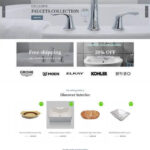
The Power of E-commerce
A Step-by-Step Guide to Creating an Online Store
In today’s digital age, the allure of owning an online store has never been greater. With the rise of e-commerce platforms and the increasing popularity of online shopping, the opportunities for entrepreneurs to establish and grow successful online businesses are abundant. If you’re considering launching your own online store, you’re in the right place. In this article, we’ll guide you through the process of creating an online store from start to finish.
1. Define Your Niche and Products
The first step in creating an online store is to define your niche and determine what products you’ll be selling. Research market trends, identify target demographics, and assess competition to find a niche that aligns with your interests, expertise, and market demand. Choose products that are unique, high-quality, and in-demand to set your store apart from the competition.
2. Choose an E-commerce Platform
Next, you’ll need to choose an e-commerce platform to power your online store. There are many options available, ranging from hosted solutions like Shopify and BigCommerce to self-hosted platforms like WooCommerce and Magento. Consider factors such as ease of use, customization options, pricing, and scalability when selecting the right platform for your business.
3. Design Your Storefront
Once you’ve chosen an e-commerce platform, it’s time to design your storefront. Select a professional and visually appealing theme or template that reflects your brand identity and resonates with your target audience. Customize your storefront with your logo, brand colors, product images, and compelling copy to create a memorable and engaging shopping experience for your customers.
4. Add Products and Categories
With your storefront design in place, it’s time to add your products and organize them into categories. Write detailed product descriptions, including features, specifications, and benefits, to help customers make informed purchasing decisions. Use high-quality images and videos to showcase your products from multiple angles and provide a clear view of their appearance and functionality.
5. Set Up Payment and Shipping Options
To facilitate transactions on your online store, you’ll need to set up payment and shipping options. Integrate trusted payment gateways like PayPal, Stripe, and Square to accept credit card payments securely. Configure shipping methods, rates, and zones based on your location and target market to provide accurate shipping estimates and options for your customers.
6. Implement Security Measures
Protect your online store and customer data by implementing robust security measures. Install SSL certificates to encrypt sensitive information transmitted between your website and customers’ browsers. Implement security plugins and measures to prevent unauthorized access, malware attacks, and data breaches. Display trust badges and security seals to reassure customers of the safety and security of their transactions.
7. Launch and Promote Your Store
With your online store set up and ready to go, it’s time to launch and promote it to attract customers and drive sales. Announce your store launch through email marketing, social media, press releases, and other marketing channels to generate buzz and excitement. Offer special promotions, discounts, and incentives to encourage first-time visitors to make a purchase and become repeat customers.
8. Monitor Performance and Iterate
After launching your online store, monitor its performance closely using analytics tools and metrics such as traffic, conversion rate, average order value, and customer lifetime value. Identify areas for improvement and iterate on your store design, product offerings, marketing strategies, and customer experience to optimize performance and drive continuous growth and success.
In conclusion, creating an online store requires careful planning, strategic decision-making, and attention to detail. By following this step-by-step guide and leveraging the right tools and resources, you can build a successful online store that attracts customers, drives sales, and grows your business in the competitive world of e-commerce.















